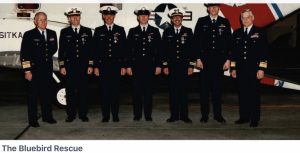Coast Guard DFC Recipient John Whiddon
Manage episode 455230948 series 3017911
Coast Guard pilot John Whiddon has been awarded two Distinguished Flying Cross medals. But the enemy he faced was not the Viet Cong or Iraqi air defenses. It was 30 foot seas, 70 knot wind gusts and freezing waters off the coast of Alaska.
John was born in England and his father served in the Royal Navy. Having finished college, he had applied for the US Coast Guard but had not received an answer. So he applied to the Royal Navy’s helicopter flying program and was accepted. The week before he was set to leave for London, he received word that he had been accepted into the US Coast Guard Officer Candidate School.
At the time, John was flying the HH-3F amphibious helicopters. They had a boat hull that would allow the aircraft to land in the water, but only in 8-10 foot seas and 8 knot winds. Following the failed rescue of the “Marine Electric” in 1983, the Coast Guard established their rescue swimmer program.
John shares details of the two rescues for which he was awarded the Distinguished Flying Cross, including the “Bluebird” rescue on December 10, 1987 off the coast of Alaska. A fisherman and his six year old son were in trouble. It was a night mission and weather conditions were terrible; blinding snow and ice, 30 foot seas and wind gusts up to 70 knots.
The winds were so strong, several times the helicopter was actually blown backyards and toward the water. At one point their rear rotor came within 3 feet of the water. Because of the size and construction of the boat, placing the rescue basket on the sinking boat was not an option. It would become the first time in Coast Guard history that a rescue swimmer was used in a high seas rescue.
After 45 minutes of failing to get the rescue basket to the swimmer and half a dozen near crashes, John and his crew began to recognize the very real possibility that they might crash themselves and, in that case, there was no one coming to rescue them. However, they didn’t give up and finally got everyone board.
John’s interview is part of our partnership with the Distinguished Flying Cross Society and our shared mission to tell the stories of heroism or extraordinary achievement in flight.
53 odcinków




